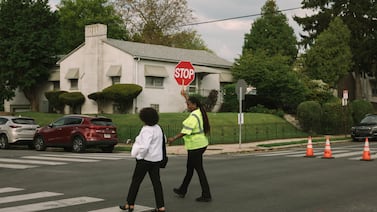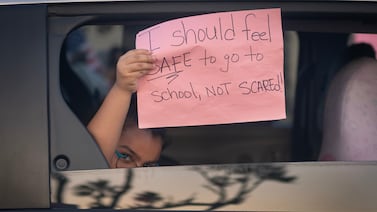Chicago Public Schools families have until Friday to decide: Will their children attend school this fall under a part-time “hybrid” plan or learn fully remotely?
That deadline comes despite many questions that remain. And while some new details have emerged about the city’s reopening plan, anxious parents, students, and educators are pressing principals and peppering each other with questions in ward meetings and Facebook groups.
The city’s tentative hybrid plan isn’t final. Chicago says its final blueprint for reopening in fall is expected in early August.
One thing is for sure: Any scenario brings with it an unprecedented set of complications, conundrums, and questions. Here are seven weighing on the minds of families.
- Is it safe to return to in-person learning?
At town hall meetings last week, district leaders said in-person instruction is most conducive to learning, and that research largely indicates children are at lower risk of COVID-19. But parents must weigh that information with the reality of rebounding case counts in Illinois and recent news about spikes in summer camps in the suburbs and neighboring states.
In the polls conducted during a series of town hall meetings last week, more than half of respondents were either somewhat or very uncomfortable with the hybrid plan.
Under that plan, first made public July 17, a “2-1-2 scheduling model” divides most students into “pods” that spend the same two consecutive days each week at school and the same two days learning at home. On Wednesdays, all students participate in live virtual instruction with their classroom teacher. (Notable exceptions: Pre-kindergarten students will have the option of attending school five days a week and high school juniors and seniors are all remote — something the district has said it is reconsidering.)
In the town halls, leaders detailed how the pod system will be enforced and how temperature screenings and staggered start times will become daily features at schools. They also introduced a new requirement that families complete an online symptom screener each morning before sending children to school.
But parents and educators lobbed plenty of other questions the district’s way, some of which didn’t get answered. What about proper ventilation? “The air filter in my classroom has not been changed in five years,” wrote one educator. (The district said it’s looking at a proposal to flush the ventilation systems two hours before students arrive and two hours after they leave.) Who is cleaning the schools and how often? “My classroom was only mopped twice that I know of,” wrote another. Parents wrote asking about special accommodations for children with underlying conditions, such as asthma, and how the district planned to deep clean pre-kindergarten classrooms, where student would go all five days.
2. How will the remote option work for families who opt out?
Parents want to know: How much support will the district provide if they choose the full-time remote option the district is offering?
Jackson said the district needs opt-out numbers to determine specifics — but that presents a chicken-or-egg conundrum for some parents who say they need specific details about the all-remote plan to make a choice.
A few things have become more clear: Families who choose hybrid learning can switch to an all-remote setup at any time, but all-remote families can’t opt back into in-person learning until the second semester.
What’s more, live instruction will likely be limited. Students who opt out of in-person classes will only have live, real-time instruction one day a week — on Wednesdays. Mostly teachers will lean on pre- recorded lessons and independent work, the district said this week.
But leaders did suggest that schools could have some flexibility. By the end of the week, Jackson said that if enough students opt into remote learning, individual schools could start assigning educators to teach all-remote classes.
Another point that leaders tried to clarify this week: Students who opt out of in-person classes will still maintain their spot at the school, including at magnet and selective enrollment schools, a significant concern for many meeting participants.
3. Will teachers come back?
Illinois’ two big statewide teachers unions and the Chicago teachers union have already flexed their muscle on this issue, threatening strikes and other actions if they feel reopening plans don’t go far enough to protect educators.
On Friday evening, Chicago’s teachers union — which has underscored its call for an all-remote start with a social media campaign and car rallies — said its own talks with district leadership remain “frustrating.” In addition to safety concerns, teacher delegates said they still hadn’t seen a working weekly schedule for the hybrid plan. “School starts in 38 days and it’s still really, really unclear what it will look like,” said Jesse Sharkey, the union’s president. Teachers said they were planning a noon rally Monday at City Hall.
4. Will individual schools have flexibility?
It’s not clear how much flexibility schools will have on finer points of the plan. But district-run schools will not adopt different learning models, leaders have said, even if different areas in the city see different COVID-19 conditions.
But leaders have signaled that some decisions may left up to schools. For example, leaders have said that students at some campuses could potentially take in-person classes more than two days a week if, for example, a building has small classrooms that allow for social distancing, even when all students are in the building.
5. Will broadband access improve?
Even as the school district has distributed more than 110,000 devices to date, one of the most vexing issues of the pandemic has been lagging broadband access in some parts of the city. Soon after schools closed, a group of researchers said one in five Chicago students lacked broadband access at home. One potential consequence: Data released in May showed that more 2,000 students completely fell out of contact with schools, a figure the district more recently revised using different methodology.
Jackson has said that the pandemic has underscored the critical need for better connectivity, and Chicago recently unveiled a plan to try and deliver broadband internet to 100,000 low-income families. “Post COVID-19, we’re going to see access to devices and internet connectivity as important as access to textbooks,” she told Chalkbeat last week.
6. Will the city step up with supplemental child care options?
In any scenario, there will be pressure from working parents of younger children to figure out child care. School district officials this week said that they are looking into partnerships with the park district and with libraries to support students on the shift schedule , but no specifics have been shared.
In New York City, the country’s largest school district with more than 1 million students, Mayor Bill de Blasio has said his administration will aim to open up 100,000 child care spots for families.
Meanwhile, some wealthier suburban districts have already started to address this question. Franklin Park District 84, in the western suburbs, has partnered with its local park district to offer remote learning day camp during school hours, as well as a childcare option in the late afternoon.
7. How much could change between now and the start of school?
A lot. Officials have said a shift in the COVID-19 infection rate could trigger an overhaul of the tentative reopening plan. Essentially, if the seven-day average of new cases rises above 400 daily in Chicago, or the number stays above 200 and there are other concerning factors — such as a drop in available hospital beds — the district would shift into an all-remote situation, leaders have said.
Officials have also said an 8% testing positivity rate would signal the virus is out of control. In New York, schools will only reopen if positivity rates are below 3%. Currently, Chicago’s positivity rate is 4.9% based on a seven-day rolling average.
If the number of cases falls below 100 a day for four weeks, that could mean a shift back to full-time, in-person instruction.
If what neighboring districts are doing is any indication (Chalkbeat is tracking reopening plans here), anything could still happen. Several districts that initially released hybrid plans have already reversed course and gone all-remote. Others have delayed the start of the year.
“As conditions evolve, our plans may change. It could be the case that we get to a level where we’d have to pivot to all remote learning. We’re not there yet, but we’re watching closely, and you can bet our eyes are on this,” said Kenneth Fox, the school district’s chief health officer.






